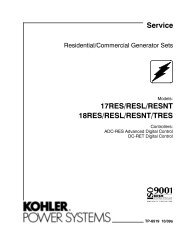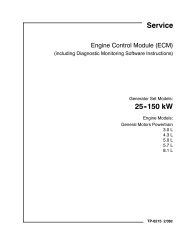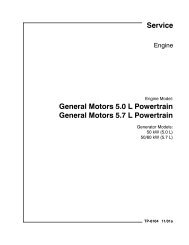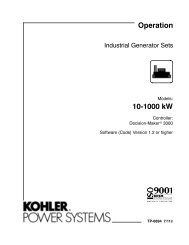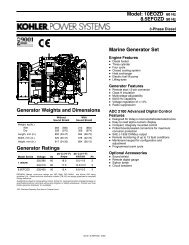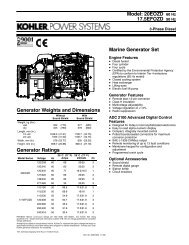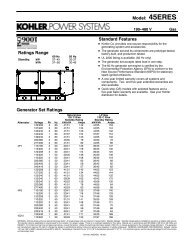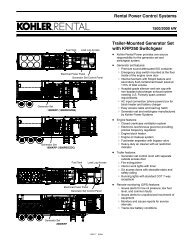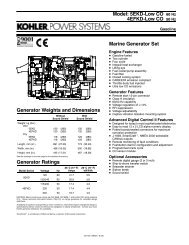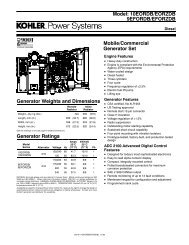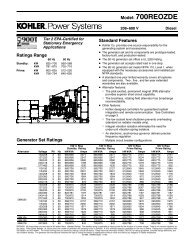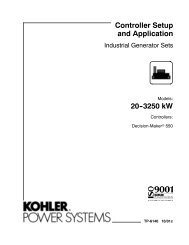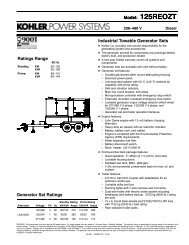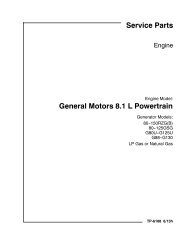Service Manual, General Motors 4.3L Engine (TP ... - Kohler Power
Service Manual, General Motors 4.3L Engine (TP ... - Kohler Power
Service Manual, General Motors 4.3L Engine (TP ... - Kohler Power
Create successful ePaper yourself
Turn your PDF publications into a flip-book with our unique Google optimized e-Paper software.
<strong>Engine</strong> Marine/Industrial <strong>4.3L</strong> 6-173<br />
The drive belt system may use one belt or two belts. The<br />
drive belt is thin so that it can bend backwards and has<br />
several ribs to match the grooves in the pulleys. There<br />
also may be a V-belt style belt used to drive certain<br />
accessory drive components. The drive belts are made of<br />
different types of rubbers (chloroprene or EPDM) and<br />
have different layers or plys containing either fiber cloth or<br />
cords for reinforcement.<br />
Both sides of the drive belt may be used to drive the<br />
different accessory drive components. When the back<br />
side of the drive belt is used to drive a pulley, the pulley is<br />
smooth.<br />
The drive belt is pulled by the crankshaft balancer pulley<br />
across the accessory drive component puleys. The<br />
spring loaded drive belt tensioner keeps constant tension<br />
on the drive belt to prevent the drive belt from slipping.<br />
The drive belt tensioner arm will move when loads are<br />
applied to the drive belt by the accessory drive<br />
components and the crankshaft.<br />
The drive belt system may have an idler pulley, which is<br />
used to add wrap to the adjacent pulleys. Some systems<br />
use an idler pulley in place of an accessory drive<br />
component when the vehicle is not equipped with the<br />
accessory.<br />
New Product Information<br />
The purpose of New Product Information is to highlight or<br />
indicate important product changes from the previous<br />
model year.<br />
Changes may include one or more of the following items:<br />
• A component comparison from the previous year<br />
• Fastener changes<br />
• Torque values and/or fastener tightening strategies<br />
• Changed engine specifications<br />
• New sealants and/or adhesives<br />
• Disassembly and assembly procedure revisions<br />
• <strong>Engine</strong> mechanical diagnostic procedure revisions<br />
• New special tools required<br />
Component Comparison<br />
• Eliminated the oil filter adapter assembly<br />
• Revised the water pump seal<br />
• Revised the engine coolant thermostat<br />
• New roller type timing chain and sprockets<br />
• New roller pivot type valve rocker arm assemblies<br />
using a one piece valve rocker arm support to<br />
replace the ball pivot type valve rocker arm system<br />
• Cylinder heads revised using dry holes for the<br />
valve rocker arm bolts<br />
Torque Values and/or Fastener Tightening<br />
Strategies<br />
• Cylinder head bolts, the crankshaft bearing cap<br />
bolts, the connecting rod bolts and balance shaft<br />
bolt apply a torque angle strategy.<br />
In an on-vehicle situation where a torque angle<br />
meter may not fit into the vehicle packaging, a<br />
three step tightening process may be followed<br />
using a torque wrench.<br />
• Certain fasteners should not be reused. Bolts,<br />
studs or other fasteners that must be replaced will<br />
be called out in the specific service procedures.<br />
Changed <strong>Engine</strong> Specifications<br />
<strong>Engine</strong> mechanical specifications remain the same as<br />
the 1999 products.<br />
New Sealants and/or Adhesives<br />
No new sealants or adhesives have been added.<br />
Disassembly and Assembly Procedure Revisions<br />
• Valve rocker arm and pushrod<br />
• Timing chain and sprockets<br />
• Discard all used gaskets, seals or O-ring seals<br />
unless otherwise indicated<br />
Gaskets, seals or O-ring seals that can be reused<br />
will be identified in the specific service procedure.<br />
<strong>Engine</strong> Mechanical Diagnostic Procedure Revisions<br />
• Valve Train diagnostic information is now provided<br />
in table form.<br />
Potential or probable causes are supplied for each<br />
specific concern.<br />
• <strong>Engine</strong> Noise diagnostic information is now<br />
provided in table form.<br />
Potential or probable causes are supplied for each<br />
specific concern.<br />
New Special Tools Required<br />
No new special tools are required.<br />
2000 Marine/Industrial



